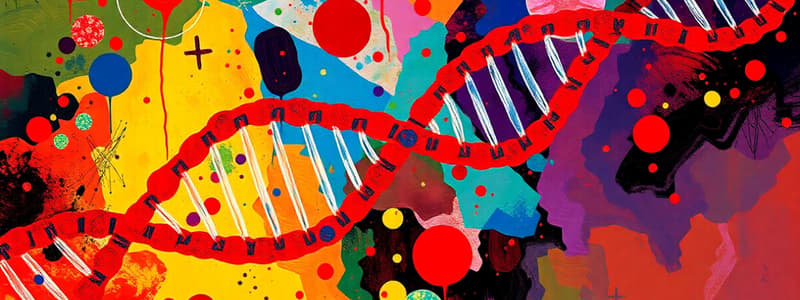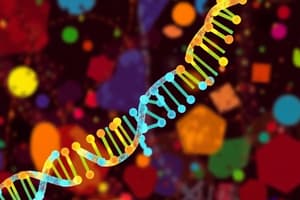Podcast
Questions and Answers
Which strand of DNA is used as the template for transcription?
Which strand of DNA is used as the template for transcription?
- The non-template strand
- The coding strand
- The promoter strand
- The template strand (correct)
What is the main function of the promoter in the transcription unit?
What is the main function of the promoter in the transcription unit?
- To serve as a coding sequence
- To initiate RNA synthesis (correct)
- To enhance RNA stability
- To terminate transcription
During transcription, which nucleotide base is replaced with uracil in RNA synthesis?
During transcription, which nucleotide base is replaced with uracil in RNA synthesis?
- Adenine
- Cytosine
- Thymine (correct)
- Guanine
What is the primary role of transfer RNA (tRNA) in protein synthesis?
What is the primary role of transfer RNA (tRNA) in protein synthesis?
Which of the following regions is NOT a part of a transcription unit?
Which of the following regions is NOT a part of a transcription unit?
Which class of small RNA molecules participates in the conversion of pre-mRNA into mRNA?
Which class of small RNA molecules participates in the conversion of pre-mRNA into mRNA?
How does transcription differ from DNA replication in the context of strands used?
How does transcription differ from DNA replication in the context of strands used?
How do microRNAs (miRNAs) primarily function within eukaryotic cells?
How do microRNAs (miRNAs) primarily function within eukaryotic cells?
What is the result of transcription in terms of nucleic acid sequences?
What is the result of transcription in terms of nucleic acid sequences?
What is the main difference between small nuclear RNAs (snRNAs) and small interfering RNAs (siRNAs)?
What is the main difference between small nuclear RNAs (snRNAs) and small interfering RNAs (siRNAs)?
Which of the following statements about transcription units is correct?
Which of the following statements about transcription units is correct?
Where are small nuclear RNAs (snRNAs) typically located within the cell?
Where are small nuclear RNAs (snRNAs) typically located within the cell?
What is the primary role of the terminator in the transcription unit?
What is the primary role of the terminator in the transcription unit?
In which direction does the transcription apparatus move during transcription?
In which direction does the transcription apparatus move during transcription?
How are nucleotides numbered around the transcription start site?
How are nucleotides numbered around the transcription start site?
Which statement accurately describes the transcription of RNA in relation to the DNA template strand?
Which statement accurately describes the transcription of RNA in relation to the DNA template strand?
Which of the following best defines a transcription unit?
Which of the following best defines a transcription unit?
What distinguishes the non-template (coding) strand in relation to the RNA produced?
What distinguishes the non-template (coding) strand in relation to the RNA produced?
Which feature is unique to RNA synthesis compared to DNA synthesis?
Which feature is unique to RNA synthesis compared to DNA synthesis?
What component is primarily responsible for executing the steps of transcription?
What component is primarily responsible for executing the steps of transcription?
What is the orientation of the coding strand when represented in nucleotide sequences?
What is the orientation of the coding strand when represented in nucleotide sequences?
Which statement about bacterial RNA polymerase is true?
Which statement about bacterial RNA polymerase is true?
What is the primary function of RNA polymerase II in eukaryotic cells?
What is the primary function of RNA polymerase II in eukaryotic cells?
How is transcription initiated in bacterial cells?
How is transcription initiated in bacterial cells?
Which RNA polymerase in eukaryotes is responsible for transcribing tRNAs?
Which RNA polymerase in eukaryotes is responsible for transcribing tRNAs?
What is the general role of accessory proteins in RNA polymerase function?
What is the general role of accessory proteins in RNA polymerase function?
Which of the following statements correctly describes eukaryotic RNA polymerases?
Which of the following statements correctly describes eukaryotic RNA polymerases?
What type of RNA is primarily transcribed by RNA polymerase I?
What type of RNA is primarily transcribed by RNA polymerase I?
Which option correctly pairs eukaryotic RNA polymerases with their functions?
Which option correctly pairs eukaryotic RNA polymerases with their functions?
What role does the sigma factor play in bacterial transcription?
What role does the sigma factor play in bacterial transcription?
Flashcards
tRNA function
tRNA function
tRNA links mRNA's nucleotide sequence to the amino acid sequence of a polypeptide chain.
snRNA function
snRNA function
snRNAs help process pre-mRNA into mRNA.
snoRNA function
snoRNA function
snoRNAs are involved in rRNA processing.
miRNA function
miRNA function
Signup and view all the flashcards
siRNA function
siRNA function
Signup and view all the flashcards
RNA synthesis template
RNA synthesis template
Signup and view all the flashcards
Template strand
Template strand
Signup and view all the flashcards
Non-template strand (coding strand)
Non-template strand (coding strand)
Signup and view all the flashcards
Transcription unit
Transcription unit
Signup and view all the flashcards
Promoter region
Promoter region
Signup and view all the flashcards
RNA-coding region
RNA-coding region
Signup and view all the flashcards
Terminator region
Terminator region
Signup and view all the flashcards
Transcription Terminator
Transcription Terminator
Signup and view all the flashcards
Transcription Start Site
Transcription Start Site
Signup and view all the flashcards
Upstream/Downstream
Upstream/Downstream
Signup and view all the flashcards
RNA Polymerase
RNA Polymerase
Signup and view all the flashcards
Transcription Unit
Transcription Unit
Signup and view all the flashcards
5' to 3' direction
5' to 3' direction
Signup and view all the flashcards
Template Strand
Template Strand
Signup and view all the flashcards
Coding Strand
Coding Strand
Signup and view all the flashcards
Transcription
Transcription
Signup and view all the flashcards
Bacterial RNA Polymerase
Bacterial RNA Polymerase
Signup and view all the flashcards
Sigma Factor
Sigma Factor
Signup and view all the flashcards
Holoenzyme
Holoenzyme
Signup and view all the flashcards
Eukaryotic RNA Polymerase types
Eukaryotic RNA Polymerase types
Signup and view all the flashcards
RNA Polymerase I
RNA Polymerase I
Signup and view all the flashcards
RNA Polymerase II
RNA Polymerase II
Signup and view all the flashcards
RNA Polymerase III
RNA Polymerase III
Signup and view all the flashcards
Promoter region (bacteria)
Promoter region (bacteria)
Signup and view all the flashcards
Core enzyme
Core enzyme
Signup and view all the flashcards
Study Notes
Gene Expression: Transcription in Prokaryotes
- RNA is a polymer of nucleotides joined by phosphodiester bonds
- RNA contains ribose sugar, uracil instead of thymine, and a hydroxyl group on the 2' carbon
- DNA nucleotides contain deoxyribose sugars, lack a free hydroxyl group on the 2' carbon, and are more stable
- RNA is less stable than DNA under alkaline conditions due to the free hydroxyl group
- RNA can have secondary structures due to hydrogen bonding between complementary bases
- RNA molecules perform various functions in cells such as ribosomal RNA (rRNA) that makes up the ribosome for protein assembly, messenger RNA (mRNA) carrying the coding instructions from DNA to ribosomes for protein synthesis, and transfer RNA (tRNA) that links mRNA codons to amino acids
Classes of RNA
- Ribosomal RNA (rRNA) forms the ribosome, the site of protein synthesis, and is found in both bacterial and eukaryotic cells
- Messenger RNA (mRNA) carries the coding sequence from DNA to the ribosome in both bacterial and eukaryotic cells
- Transfer RNA (tRNA) links codons in mRNA to specific amino acids in both bacterial and eukaryotic cells
- Small nuclear RNAs (snRNAs) are involved in processing pre-mRNA into mRNA in eukaryotic cells
- Small nucleolar RNAs (snoRNAs) are involved in processing rRNA in eukaryotic cells
- MicroRNAs (miRNAs) and small interfering RNAs (siRNAs) are involved in RNA interference (RNAi) in eukaryotic cells. RNA interference regulates gene expression by degrading mRNA or inhibiting translation
The Concept of Transcription
- All cellular RNAs are synthesized from DNA templates during transcription
- During replication, all nucleotides in DNA are copied
- During transcription, only small parts (single genes or a few genes) of the DNA molecule are transcribed into RNA.
- Transcription is a highly selective process; individual genes are transcribed only as needed or when their products are needed
- Transcription requires DNA template, raw materials (substrates) to build RNA molecules, and the transcription apparatus
The Template for Transcription
- The template for RNA synthesis is a single strand of the DNA double helix
- The transcription of a gene takes place on one of the two DNA nucleotide strands
- The nucleotide strand used for transcription is called the template strand.
- The non-template strand is not ordinarily transcribed and is also referred to as the coding strand, which has the same sequence as the RNA molecule, except that it replaces thymine (T) with uracil (U)
The Transcription Unit
- A transcription unit is a DNA segment that encodes an RNA molecule.
- Each transcription unit contains a promoter, RNA-coding region, and a terminator.
- The promoter is a DNA sequence that the transcription apparatus recognizes and binds.
- The RNA-coding region is a DNA sequence that is copied into an RNA molecule.
- The terminator is a DNA sequence that signals where transcription ends.
- The sequence of the non-template strand is written with the 5' end on the left and 3'end on the right, while the sequence of the RNA transcript proceeds in the 5'-3' direction.
The Transcription Apparatus
- The RNA polymerase carries out all the required steps of transcription.
- RNA polymerase is enhanced by various accessory proteins during transcription
- Bacterial cells typically possess one type of RNA polymerase responsible for all classes of bacterial RNA (mRNA, tRNA, and rRNA).
- RNA polymerase is a large multimeric enzyme containing polypeptide chains
- The core enzyme binds with a sigma factor to form a holoenzyme during transcription.
- The sigma factor controls RNA polymerase binding to the promoter, and initiates transcription at a proper start site.
- Eukaryotic RNA polymerase are large multimeric enzymes, consisting of more than a dozen subunits.
- Eukaryotic cells have three distinct types of RNA polymerases.
- RNA polymerase I transcribes large rRNA (ribosomal RNA).
- RNA polymerase II transcribes pre-mRNAs (pre-messenger RNA) along with some snoRNAs, miRNAs, and snRNAs.
- RNA polymerase III transcribes tRNAs and small rRNAs along with some miRNAs, and snRNAs
- RNA polymerase IV transcribes some siRNAs in plants
The Process of Bacterial Transcription
- Transcription occurs in three stages:
- Initiation: Transcription apparatus assembles and begins RNA synthesis on the promoter
- Elongation: RNA polymerase unwinds the DNA, adding nucleotides to the 3' end of the growing RNA
- Termination: Recognition of the end of the transcription unit, ending RNA separation from the DNA template
Initiation
- A consensus sequence is stretches of nucleotides within the DNA found in the promoter region.
- The common consensus sequence in bacterial promoters is centered about 10 bp upstream of the start site, and is called the -10 or Pribnow box.
- The -35 consensus sequence is located ~35 bp upstream of the start site.
- A promoter is a DNA sequence adjacent to a gene and required for transcription
Elongation
- RNA polymerase moves along the template DNA from 3' to 5', producing the RNA transcript by adding nucleotides to the 3' end of the growing RNA.
- Transcription takes place within a short stretch of DNA (~18 nucleotides) called the transcription bubble.
Termination
- RNA polymerase transcribes a specific terminator sequence
- Transcription stops after the terminator has been transcribed
- RNA polymerase stops synthesizing the RNA molecule , detachs from the DNA template and releases the RNA transcript.
Studying That Suits You
Use AI to generate personalized quizzes and flashcards to suit your learning preferences.




